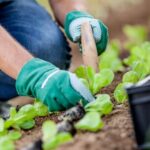Are you looking to add fresh, homegrown vegetables to your diet? The growing trend of vegetables from gardens offers a rewarding way to incorporate nutritious produce into your meals. There are numerous benefits to growing your own vegetables, including the convenience of having access to fresh produce right in your backyard, the satisfaction of cultivating your own food, and the opportunity to reduce your environmental impact.
With an increasing interest in sustainable living and self-sufficiency, more and more people are turning to vegetable gardening as a way to take control of what they eat. Whether you have limited space in an urban setting or ample room in a suburban or rural environment, vegetable gardening is a versatile and accessible activity for individuals and families alike.
Not only does it provide a source of fresh, healthy produce, but it also fosters a connection to nature and promotes environmental stewardship.
In this article, we will explore the various aspects of vegetable gardening, from getting started with the right vegetables for your location to maintaining a healthy garden and harvesting your homegrown bounty. We will also delve into the nutritional benefits of consuming fresh vegetables from your garden and discuss how sustainable practices can lead to a reduced carbon footprint. So let’s dig in and discover the joy of cultivating your own delicious and nutritious vegetables at home.
Getting Started
When getting started with your vegetable garden, it’s important to choose the right vegetables that are suitable for your climate, soil, and sunlight conditions. Here are some tips to help you make the best choices for your garden:
- Consider your climate: Different vegetables thrive in different climates. Research which vegetables are best suited for the weather conditions in your area. For example, leafy greens like lettuce and spinach tend to do well in cooler temperatures, while tomatoes and peppers prefer warmer climates.
- Evaluate your soil: It’s important to understand the composition of your soil before selecting which vegetables to plant. Some vegetables prefer well-draining soil, while others may thrive in more moisture-retentive soil. Conduct a soil test to determine the pH level and nutrient content of your soil to ensure optimal growth for your chosen vegetables.
- Assess sunlight requirements: Most vegetables require at least 6-8 hours of sunlight per day. Take note of areas in your garden that receive direct sunlight versus those that are shaded throughout the day. This will help you determine which vegetables will thrive in various parts of your garden.
By considering these factors, you can select the best combination of vegetables from gardens that will grow successfully in your specific gardening environment. Once you have identified the right vegetables for your garden, you can move on to planning and preparing for the planting process.
Planting Process
When it comes to planting vegetables in your garden, there are several important factors to consider to ensure a successful harvest. The first step is to choose the right seeds or seedlings for your climate and growing conditions. Consider the amount of sunlight your garden receives, as well as the type of soil you have.
Some vegetables thrive in full sun, while others prefer partial shade. Similarly, certain vegetables require well-draining soil, while others can tolerate heavier clay-based soil.
Once you have selected the appropriate seeds or seedlings, it’s time to consider the transplanting process. For some vegetables, such as tomatoes and peppers, starting them indoors from seeds before transplanting them into your garden can lead to better results. However, other vegetables like carrots and radishes should be sown directly into the ground due to their delicate root systems.
Maintaining soil health is crucial for the success of your vegetable garden. This includes regular watering, adding organic compost or fertilizer as needed, and rotating crops to prevent nutrient depletion. Proper soil maintenance not only ensures healthy plant growth but also contributes to the overall health of your homegrown vegetables.
To summarize:
Important steps in planting process:
- Choose appropriate seeds or seedlings for your climate and growing conditions
- Consider transplanting certain vegetables from indoor starts
- Maintain soil health through watering, fertilizing, and crop rotation
By following these steps and maintaining a healthy garden environment, you can expect a bountiful harvest of fresh and nutritious vegetables from your own backyard.
Maintenance
Maintaining a healthy vegetable garden requires consistent care and attention to ensure optimal growth and yield. One of the most important aspects of maintenance is proper watering. Different vegetables have varying water needs, so it’s essential to research and understand the specific requirements of the vegetables you’re growing.
In general, most vegetables need about 1-1.5 inches of water per week, either from rainfall or irrigation. It’s important to water deeply and less frequently to encourage strong root growth and prevent shallow root development.
In addition to watering, fertilizing is another key aspect of maintaining a healthy vegetable garden. Before planting, it’s crucial to prepare the soil with organic matter such as compost or well-rotted manure to provide essential nutrients for plant growth.
During the growing season, regular fertilizer applications can help ensure that your vegetables receive the nutrients they need to thrive. It’s important to choose a fertilizer that is appropriate for the specific needs of your plants and apply it according to the instructions on the packaging.
Pest control is also an integral part of maintaining a healthy vegetable garden. Common pests that can damage vegetable crops include aphids, caterpillars, and beetles. There are various methods for controlling pests in a garden without resorting to chemical pesticides, such as using physical barriers, companion planting, and introducing beneficial insects.
It’s important to regularly inspect your plants for signs of pest infestation and take appropriate action to prevent widespread damage. By implementing these maintenance techniques, you can ensure that your vegetable garden remains healthy and productive throughout the growing season.
| Maintenance Tip | Description |
|---|---|
| Proper Watering | Research specific water needs of each vegetable; water deeply and less frequently. |
| Fertilizing | Prepare soil with organic matter before planting; apply suitable fertilizer during growing season. |
| Pest Control | Inspect plants regularly for pests; use natural pest control methods. |
Harvesting
When it comes to harvesting leafy greens like lettuce and spinach, it’s best to pick the outer leaves first while allowing the inner leaves to continue growing. This method, known as “cut-and-come-again,” allows for a continuous harvest throughout the growing season.
For root vegetables such as carrots and radishes, gently loosen the soil around the plant before pulling them out. Be sure to harvest root vegetables promptly once they reach maturity to prevent them from becoming woody or bitter.
Tomatoes should be picked when they are fully colored but still firm. Gently twist them off the vine to avoid damaging the plant. Peppers, on the other hand, can be harvested at any stage of ripeness, depending on your preference. Regularly picking peppers encourages more fruit production.
One way to extend the harvesting season is by succession planting, which involves sowing seeds or planting seedlings at intervals in order to have a continuous supply of fresh produce throughout the season. By following proper harvesting techniques and taking advantage of methods like succession planting, you can maximize your garden’s yield and enjoy a bountiful harvest of homegrown vegetables.
| Vegetable | Harvesting Technique |
|---|---|
| Lettuce/Spinach | Cut outer leaves first for continuous harvest |
| Carrots/Radishes | Gently loosen soil around plant before pulling out |
| Tomatoes | Pick when fully colored but still firm; gently twist off vine |
| Peppers | Harvest at any stage of ripeness; regular picking encourages more fruit production |
Storage and Preservation
When it comes to growing vegetables from gardens, the harvest can often produce more than can be consumed immediately. Proper storage and preservation techniques are essential for making the most of your homegrown produce. Whether you have a surplus of tomatoes, cucumbers, or leafy greens, understanding how to store and preserve your vegetables will help ensure that you can enjoy the fruits of your labor for many months to come.
Proper Storage Methods
After harvesting your vegetables, it’s crucial to store them properly to maintain their freshness and flavor. Some vegetables, like carrots and beets, can be stored directly in the ground until needed. Others, such as potatoes and onions, should be kept in a cool, dark place with good ventilation. Leafy greens should be washed, dried thoroughly, and then stored in airtight containers or bags in the refrigerator.
Techniques for Preserving Surplus Produce
When faced with an abundance of homegrown vegetables, preservation techniques such as canning, freezing, and pickling can help extend their shelf life. Canning is ideal for preserving tomatoes and other high-acid vegetables, while freezing works well for items like green beans and peas. Pickling is a great way to preserve cucumbers and other crunchy vegetables. By learning these techniques, you can enjoy your homegrown produce long after the growing season has ended.
Maximizing Your Harvest
In addition to storing and preserving individual vegetables, consider making use of any leftover scraps or less desirable parts of your harvest. Vegetable scraps like carrot tops and onion skins can be used to make flavorful broths.
Excess produce that may not last long in storage could also be shared with friends or donated to local food banks. By finding creative ways to maximize your harvest, you can reduce food waste while sharing the rewards of your vegetable garden with others in your community.
Health and Nutrition
Freshly harvested vegetables from gardens are not only delicious but also packed with essential nutrients that can benefit overall health. Whether it’s the vibrant colors of leafy greens or the rich flavors of ripe tomatoes, homegrown produce offers a myriad of health benefits that go beyond just taste. In this section, we will explore the nutritional advantages of consuming fresh vegetables from your garden and delve into the impact of homegrown produce on overall health.
Nutrient Content
One of the primary advantages of growing your own vegetables is the opportunity to consume nutrient-dense produce. Freshly picked vegetables are at their peak in terms of nutritional content, as they are not subject to long periods of transportation or lengthy storage times.
Homegrown vegetables are rich in essential vitamins, minerals, and antioxidants, providing a nourishing source of nutrients for optimal health. From vitamin C in peppers to potassium in potatoes, homegrown vegetables offer a diverse array of essential nutrients to support overall well-being.
Impact on Overall Health
The impact of consuming fresh vegetables from gardens on overall health cannot be overstated. Incorporating homegrown produce into your diet can contribute to improved digestion, enhanced immune function, and reduced risk of chronic diseases such as heart disease and certain types of cancer. Additionally, the consumption of homegrown vegetables can lead to increased energy levels and a heightened sense of well-being due to their high nutrient content.
Connection to Nature
In addition to the direct health benefits, growing your own vegetables fosters a stronger connection to nature and a greater appreciation for where our food comes from. This connection can have positive effects on mental well-being and emotional fulfillment, reinforcing the importance of the sustainable practice of vegetable gardening for both personal and environmental health.
Sustainability
In conclusion, growing your own vegetables in a home garden not only provides the satisfaction of nurturing and harvesting your own food, but it also offers numerous benefits to the environment and overall health. By reducing food miles, minimizing food waste, and fostering a connection to nature, individuals can contribute to a more sustainable lifestyle while enjoying the freshest produce available.
The act of cultivating vegetables at home allows for a deeper appreciation of the natural world and promotes a sense of responsibility towards the environment.
Furthermore, consuming vegetables from gardens ensures that you are getting the freshest and most nutrient-rich produce possible. This fresh bounty boasts higher vitamin and mineral content compared to store-bought alternatives. Additionally, knowing exactly where your vegetables come from gives you peace of mind regarding any potential pesticides or chemicals used in their growth.
By embracing vegetable gardening, individuals can make a positive impact on both personal health and environmental sustainability. As more people become aware of the advantages of homegrown produce, there is potential for a widespread shift towards more conscious living and consumption habits. Whether you have ample outdoor space or just a small balcony or windowsill, starting a home garden can truly make a difference in promoting healthier lifestyles and preserving our planet for future generations.
Frequently Asked Questions
What Vegetables Do You Grow in a Garden?
In my garden, I grow a variety of vegetables such as tomatoes, peppers, cucumbers, carrots, spinach, lettuce, and zucchini. I also like to plant herbs like basil, parsley, and mint.
What Are the 10 Easiest Vegetables to Grow?
The 10 easiest vegetables to grow are lettuce, radishes, carrots, green beans, zucchini, cucumbers, tomatoes, peppers, spinach, and peas. These vegetables are low-maintenance and perfect for beginner gardeners.
Can You Eat Vegetables Straight From the Garden?
Yes, you can definitely eat vegetables straight from the garden. In fact, many people believe that fresh-picked vegetables taste better than store-bought ones. Just make sure to wash them thoroughly before consuming them to remove any dirt or potential contaminants.

If you’re looking to get into vegetable gardening, or are just looking for some tips on how to make your current garden better, then you’ve come to the right place! My name is Ethel and I have been gardening for years. In this blog, I’m going to share with you some of my best tips on how to create a successful vegetable garden.





